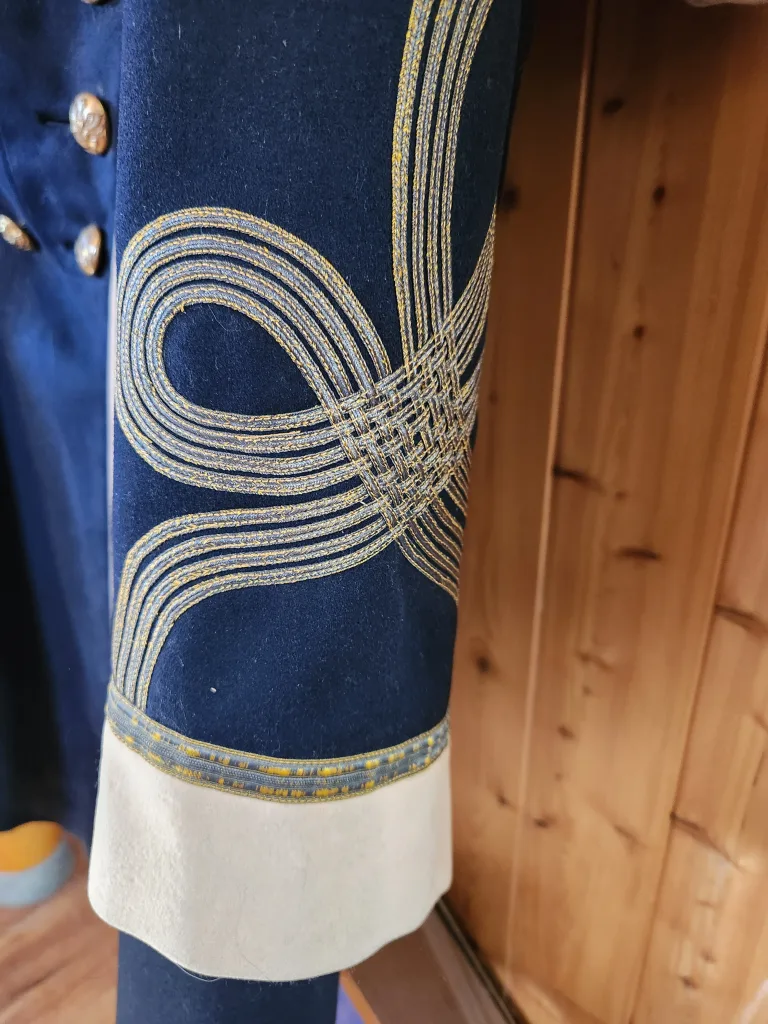

Several years ago, when I was still riding with Company M, U.S. Army 7th Cavalry memorial regiment, I became friends with one of the older members of the unit. We were both very interested in the frontier military, and each had a collection of artifacts and reproduction items.
At one of our events he was talking to me about “slowing down a bit” and wondered if I was interested in a few old items that he had acquired. We agreed to meet at his house so I could look at the frontier Army items he mentioned.
At the appointed time he showed me some old shell casings, original uniform buttons, and the like – interesting but not particularly unusual. Just as I was about to leave, he opened an old trunk and asked me if I was interested in an old uniform. He pulled out a blue officer’s coat that got my attention immediately.
The coat was beautiful. Wool, lined with cotton, double-breasted, original buttons, with a gold collar, and gold ornamental piping on the sleeves. Jaw dropping for a frontier military enthusiast. I knew immediately I was not leaving that house without that coat.

“Don’t think I have anything to trade for that,” I said.
“Just take it. You love history just like me. Take it,” he replied.
The U.S Army switched from blue to green in 1917, so I knew the coat was old. It wasn’t until 1949 that the U.S. Air Force donned the blue. Now, whose coat was it?
Inside the coat on the right side was a small pocket which I knew sometimes carried the name of the coat’s owner. We looked inside that pocket with a flashlight and found sewn there a label with Col. R. M. Schofield, Dec. 1912, U.S.A. That tailor’s name was sewn inside the collar – John. G. Haas. A Hass label was on many officer’s jackets during that time.
According to an obituary published in The Oregonian on November 7, 1941, Schofield died at age 74. Born in 1867 in Richmond, Virginia, Richmond M. Schofield was the fourth son of Lieutenant General John M. Schofield, a Medal of Honor recipient for gallantry during the Civil War and Commanding General of the Army from 1888-1895.
It was John Schofield who was sent to Hawaii to assess its value as a strategic naval location. Schofield Barracks, constructed in 1908, was named after him.
Ironically, his son, Richmond, was stationed in Hawaii in 1918 with the rank of colonel. His military service began in 1891 as a second lieutenant in the 5th Cavalry. He later served on his father’s staff as well when he commanded the Army under President Grover Cleveland.
To me the old blue coat is a piece of history. What stories it could tell!
Perhaps Richmond was wearing it while his father recounted his Civil War battles or told stories of his time as Secretary of War under President Andrew Johnson, successor to the assassinated Abraham Lincoln. It’s possible. John Schofield passed away in 1906, 15 years after Richmond began his military career.
I’m still curious about the ornate piping on the sleeves of the coat, and the golden cuffs. Both patterns, I believe, were unusual in 1912. My guess is Richmond had the fanciest coat at the ball.